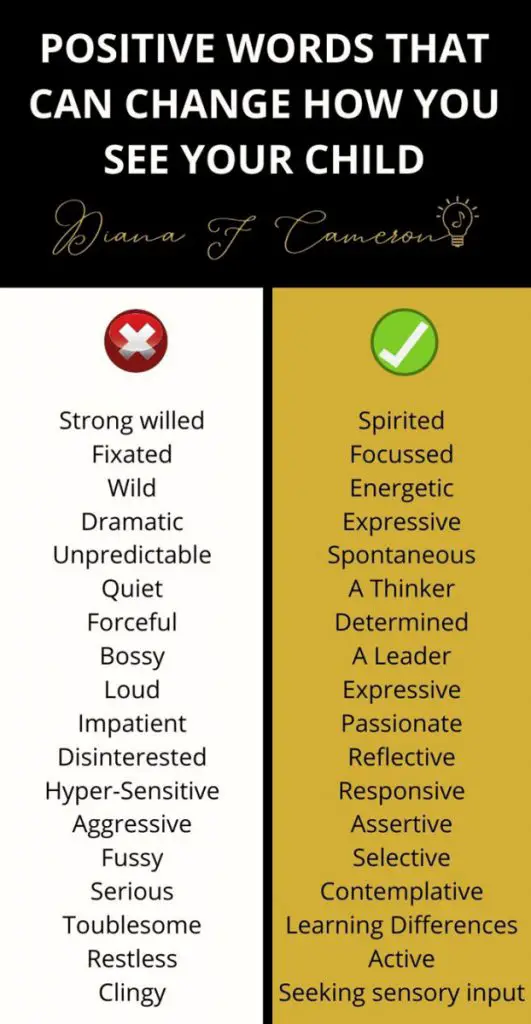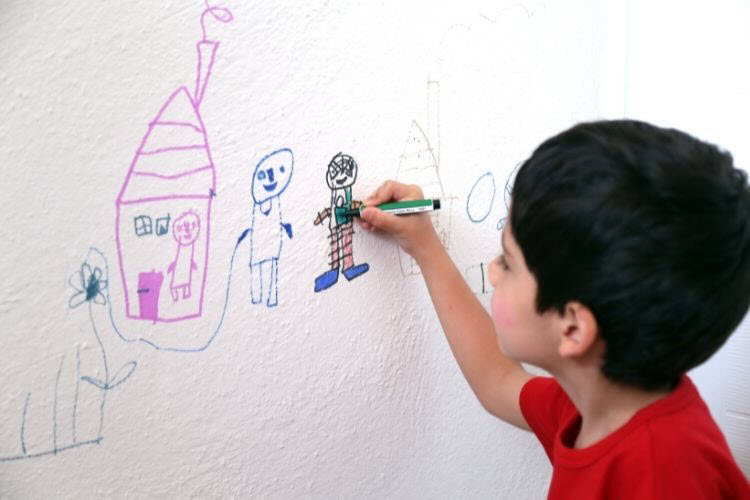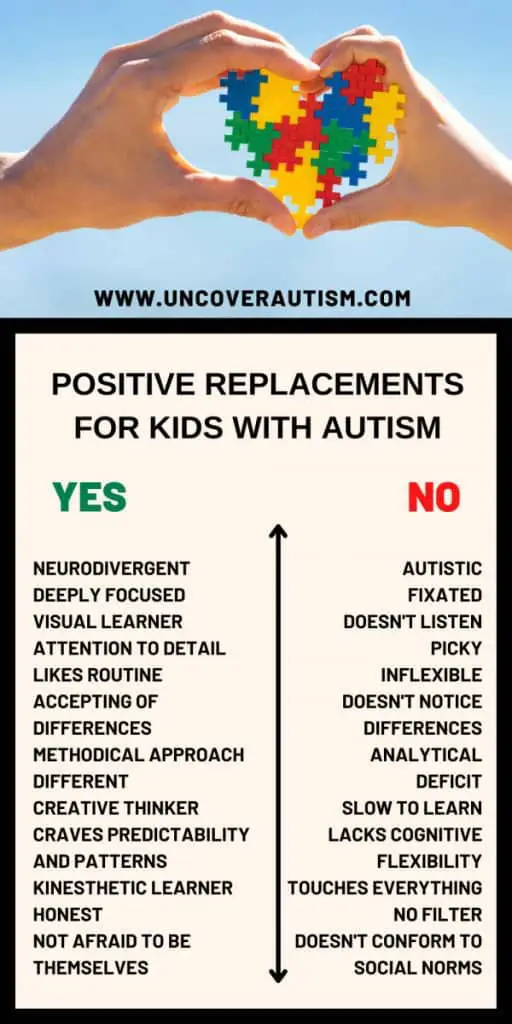With children with autism using positive words can be difficult to find in the moment when you are frustrated, and they don’t appear to be listening. You may be a parent of a child that you suspect may be on the autism spectrum, or you may have received a diagnosis. Your child may be displaying behaviors that are unusual or they may have other co-morbid disorders that make life challenging.
Regardless of your situation, you are exhausted, struggling to understand your child and their behavior which often doesn’t make sense and you don’t know how to help.

There are Two Things to Consider
- How We Speak About Autism Itself – the language we use to describe autism can be negative or positive depending on what words we choose and may even affect our perception of how we see our child. Learning of and using the more positive terms are important for both interactions between you and for others listening.
- How We Speak to Our Child – Patience can run thin and when you are running on empty it is sometimes easy to get into the rut of using negative language over and over. What a child hears, even though they may not seem to be listening to you, is incredibly important. Children process sound 24/7 and your words have impact, even when you are frustrated and tired.
Monitoring Words We Use in Relation to Autism
Years ago, people were referred to as “autistic” or having Aspergers. Terms have changed over the years to not represent a condition but rather a person.
The terms neurodivergent, or neurodivergence have become popular and words such as Asperger’s, high and low functioning are no longer being used. Neuroatypical and neurotypical are also used to describe those with autism and those without.
There are many positive words to describe autism that can be used when describing the traits that look at things from the positive rather than negative point of view. For example:
Rather than “fixated” a neurodivergent child is “deeply focused”.
Rather than “inflexible” a person with autism “prefers routine”.
Click on the image below to download a PDF of suggested alternatives for negative words.
Choosing Positive Words When Speaking with Your Child
It can be difficult in frayed moments to find positive things to say but using positive language can change your perspective.
The change of one word can completely alter the dynamic of the way you think and allows the brain to explore a different direction
Diana F Cameron
One way of changing your negative thoughts and consequent language is to change how you speak. Using positive terms and language not only helps your child, but it also changes how your brain sees the situation.
This site is called Uncover Autism because there are many wonderful things to discover as you uncover your child’s special qualities. Finding them and seeing them can be challenging but focusing on the positive will change how you see your individual situation.

Rather than “learning challenges” your child experiences “learning differences.” They still learn, but differently to other children.
Uncovering the way in which your child learns is a journey of discovery that can lead you to learn wonderful things about them.
Just that simple change of one word completely alters the dynamic of the way you think and allows the brain to explore a different direction. To be “challenged” is a negative view, suggesting deficits and “problems”.
To have “differences” is a positive approach, suggesting alternate ways of looking at things, not necessarily worse. Understanding your child’s differences can help you know how to present things in a way that they can understand and makes sense to them.
Replacing Negative with Positive

It is too late in the heat of the moment when you are frustrated and exhausted to start thinking about alternative language.
It is important to practice it when you are calm. It will become a habit and you will find you build a toolbox of vocabulary that you can turn to in challenging times.
Here are some examples of words that have negative connotations and replacement words that express a positive angle for the same trait.
You may not even speak these words out loud but use them to change how your brain sees your child.
Many children with autism can be loud and this can wear down a parent when they have noise over an extended period.
Changing your thought patterns to “expressive” allows the brain to think of the situation differently and to see a positive version of that same event.
Using Positive Language to Teach Alternative Behavior to a Child with Autism
First, it is important to know when a window of opportunity presents itself to use language to teach a child with autism. Changing behavior for those children with autism is not easy and takes time, longer for some children than others.
The first thing you need to do is to get your child’s attention. As many find auditory input challenging, you may need to touch them on the shoulder or on the arm and to make eye contact with them.
Observe your child and when you see a behavior (good or bad) use language to describe the behavior.
Describing the behavior accurately and simply is important. Don’t use questions or ambiguous language. For example, if you have a child throwing blocks across the room, after you have secured their attention say, “You threw the blocks across the room.”
This describes accurately what you just saw and is far clearer to a child with autism than saying something like “what are you doing?” “Why did you do that?”
It also helps you to concentrate on what you are seeing (the behavior) rather than how it is making you feel (frustrated).
Here is another example. See if you can choose the correct sentence:

- Why did you do that?
- You are in so much trouble!”
- You drew on the wall
- You are so naughty!
As you can see the third statement clearly describes the behavior.

- I told you not to do that
- Why don’t you listen to me?
- You are in trouble now!
- You pulled all the washing out
Sentence 4 is the one that clearly describes the behavior
Children with autism do not understand ambiguous language, sarcasm, or humor. They are extremely literal and to effect change you first need to speak in a way that they can clearly understand what you mean.
This is also important when describing what you want them to do to replace the behavior you have just seen. Instructions need to be clear, unemotional, and specific.
This type of language works well when you see positive behavior you want them to repeat. Rather than language that is not meaningful such as “Great job” or “Fantastic work”, describe the behavior you just saw in detail.
“You just looked Grandma in the eyes and said hello”. Reaffirming the behavior and describing it, helps children with autism to know exactly what you want them to do or not do. That doesn’t mean the learning comes easily, but it does give them a frame of reference to work with that makes sense to them and allows you to deal with the facts and not bring emotional responses into it.

